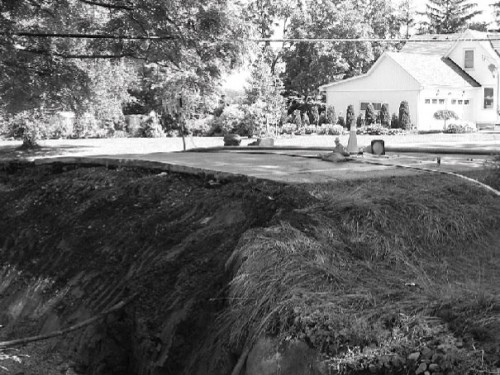County News
Rough roads

 Eastern Ontario communities drowning under road and infrastructure costs
Eastern Ontario communities drowning under road and infrastructure costs
It is an ugly picture being painted by the Eastern Ontario Warden’s Caucus. The million or so folks who live in the 114 municipalities that form Eastern Ontario are older and greyer than the provincial average; a higher proportion live on fixed incomes. The debt burden of their municipalities has risen nearly 300 per cent in the past decade.
Their tax burden has been pushed to eyewatering levels, yet these communities are falling behind in maintaining roads, bridges and other mandated services. In a frantic effort to tread water, municipalities are being forced to slash community services, parks, museums and libraries, even as they know that eliminating all these services won’t fix their structural problems.
Unlike other parts of the province, Eastern Ontario can’t look to business and industry to correct its finances: more than 90 per cent of property taxes in Eastern Ontario are paid by homeowners.
Worse, the EOWC is predicting a $500 to $600 million annual shortfall in the years ahead if something doesn’t change.
“It is a bleak picture,” said Mayor Peter Mertens. “But increasingly this is the picture emerging in Eastern Ontario. Meeting the needs of our communities is becoming more than can be managed by the property taxpayer.”
12 YEARS IN THE MAKING
The deck was stacked against Eastern Ontario when Mike Harris decided to download roads and infrastructure to municipalities.
Eastern Ontario’s rural regions are responsible for maintaining 70,000 lane/kilometres of roads—a distance that would stretch one and half times around the globe. More than 70 per cent of all roads in Eastern Ontario are located in rural areas of this region.
These rural communities have seen their debt levels rise and their reserves shrink over the last decade as they struggled to keep up with the infrastructure needs in their community.
Some stumbled into infrastructure projects beyond their expertise and competency, making matters worse.
The County constructed a new sewage treatment plant in Picton last year (pumping the town’s sewage uphill to be processed before turning the effluent around and sending it back into Picton Bay). The final cost will be more than $30 million. The province and federal government committed to funding a third of the cost— but in the end provided just $5.3 million each or about a sixth of the total cost. County water and sewer users bear fully two thirds of the cost of this facility. That wasn’t the original idea but that was the result.
County ratepayers learned the hard way their municipality didn’t have the skill set or experience to undertake this scale of project. This has happened to greater or lesser degrees across all 114 municipalities of Eastern Ontario.
Mertens says the EOWC is making these points forcefully to the province and federal government even as both are under pressure to cut spending and reduce deficits. But Mertens says that the current arrangement is broken— at least for Eastern Ontario.
“We are very much a risk that municipalities will continue to be stripped away until they become merely providers of provincially mandated services.”
Mertens observes that across the region municipal leaders are being forced to choose between parks and roads. Between police services and libraries. Between water and museums.
“The role of the municipality is to create and nurture communities,” said Mertens. “It is not to look after roads and infrastructure at the expense of our libraries and museums. If having a tough discussion to accomplish this has to happen— so be it.”
The solution isn’t to load more taxes on the backs of property taxpayers—many of whom live on incomes that have not kept up with tax increases in the past year, according to Mertens.
FIX THE PROBLEM
He is looking to the province to pay its fair share for property taxes on Crown land. Currently the province pays just a fraction of the amount it would be liable for if it were privately owned.
He also wants the province to inject more money into the Ontario Municipal Partnership Fund (OMPF) rather than shrink it. This is a funding mechanism originally designed specifically to even out the imbalances created when roads and other infrastructure maintenance requirements were downloaded onto municipal taxpayers. But in recent years the County has seen its OMPF funding decline.
Mertens also says the province must take more responsibility for Eastern Ontario roads, bridges and other infrastructure.
“We can no longer avoid this discussion,” said Mertens. “These problems only get worse next year.” Mertens is also acutely aware that slashing the things people love and value in their community isn’t a solution at all—at best it merely delays the inevitable reckoning with the province over who does what, and who should pay.
He wants the EOWC report to be the starting point for a new and urgent dialogue with the provincial government.

Comments (0)